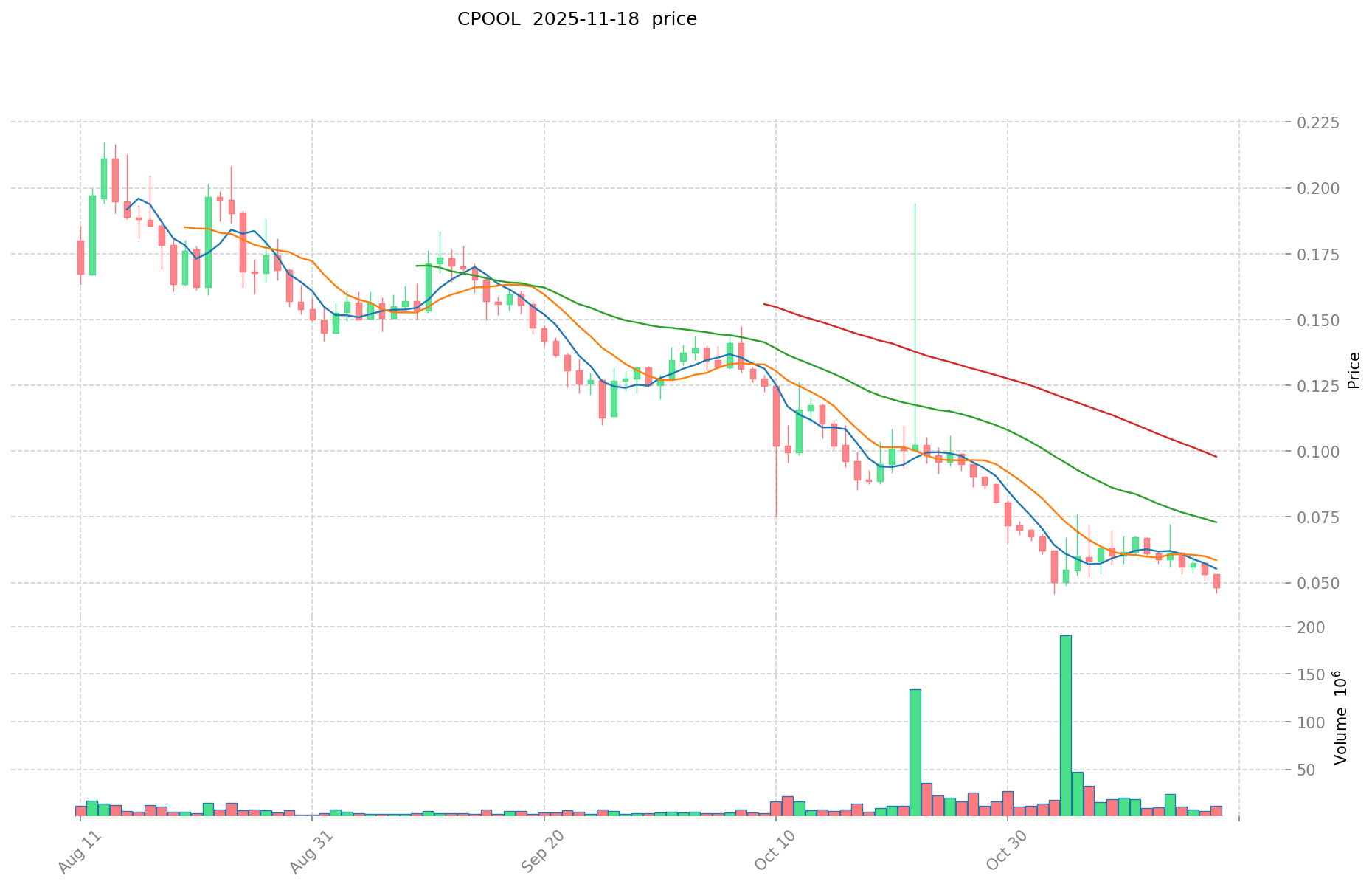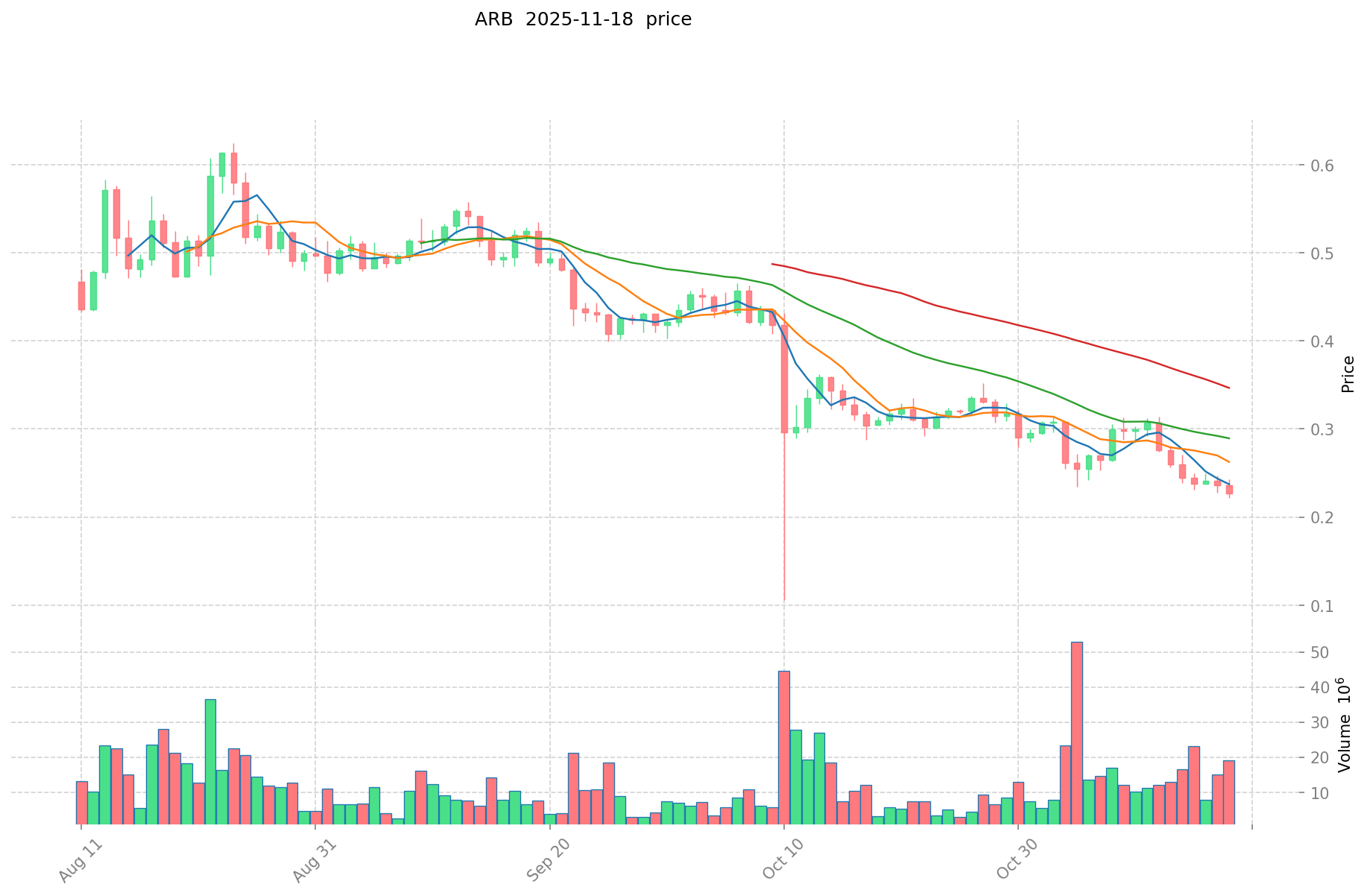CPOOL vs ARB: Analyzing the Performance and Potential of Two Emerging Blockchain Protocols
Introduction: Investment Comparison between CPOOL and ARB
In the cryptocurrency market, the comparison between Clearpool vs Arbitrum has been an unavoidable topic for investors. The two not only differ significantly in market cap ranking, application scenarios, and price performance, but also represent different crypto asset positioning.
Clearpool (CPOOL): Since its launch in 2021, it has gained market recognition for its role in decentralized capital markets.
Arbitrum (ARB): Introduced in 2023, it has been hailed as an Ethereum scaling solution, offering high-throughput and low-cost smart contracts while maintaining trustless security.
This article will comprehensively analyze the investment value comparison between CPOOL vs ARB, focusing on historical price trends, supply mechanisms, institutional adoption, technical ecosystems, and future predictions, attempting to answer the question investors are most concerned about:
"Which is the better buy right now?"
I. Price History Comparison and Current Market Status
CPOOL (Coin A) and ARB (Coin B) Historical Price Trends
- 2021: CPOOL reached its all-time high of $2.55 on November 16, 2021.
- 2023: ARB was launched in March 2023, with its price peaking at $4.00 shortly after launch.
- Comparative analysis: Since their respective highs, CPOOL has fallen to a current price of $0.04409, while ARB has declined to $0.2302.
Current Market Situation (2025-11-18)
- CPOOL current price: $0.04409
- ARB current price: $0.2302
- 24-hour trading volume: $750,905 (CPOOL) vs $5,509,107 (ARB)
- Market Sentiment Index (Fear & Greed Index): 11 (Extreme Fear)
Click to view real-time prices:
- View CPOOL current price Market Price
- View ARB current price Market Price


Comparative Investment Analysis: CPOOL vs ARB
Key Factors Affecting CPOOL and ARB Investment Value
Supply Mechanism Comparison (Tokenomics)
- CPOOL: Limited information available regarding token supply model
- ARB: Governance token with distribution mechanism tied to Ethereum Layer 2 scaling solution
- 📌 Historical pattern: Token distribution and supply mechanisms directly influence price volatility and long-term value stability
Institutional Adoption and Market Applications
- Institutional holdings: Limited comparative data on institutional preference between these tokens
- Enterprise adoption: ARB has gained traction in the Layer 2 scaling ecosystem for Ethereum applications
- Regulatory attitudes: Varying regulatory approaches across jurisdictions impact both tokens' market position
Technological Development and Ecosystem Building
- ARB technological upgrades: Continuous improvements to Ethereum Layer 2 scaling solution enhancing transaction throughput and reducing fees
- Network growth: ARB's value closely tied to its network expansion and user adoption rate
- Ecosystem comparison: ARB features more developed infrastructure for DeFi applications and cross-chain interoperability
Macroeconomic Factors and Market Cycles
- Performance in inflationary environments: Both tokens subject to broader crypto market trends
- Monetary policy impacts: Interest rates and USD index fluctuations affect trading volumes and valuations
- Transaction demand: Market utility and practical applications drive fundamental value for both projects
III. 2025-2030 Price Prediction: CPOOL vs ARB
Short-term Prediction (2025)
- CPOOL: Conservative $0.0423 - $0.0441 | Optimistic $0.0441 - $0.0608
- ARB: Conservative $0.2035 - $0.2313 | Optimistic $0.2313 - $0.3169
Mid-term Prediction (2027)
- CPOOL may enter a growth phase, with estimated prices $0.0475 - $0.0720
- ARB may enter a bullish market, with estimated prices $0.1806 - $0.4782
- Key drivers: Institutional capital inflow, ETF, ecosystem development
Long-term Prediction (2030)
- CPOOL: Base scenario $0.0503 - $0.0883 | Optimistic scenario $0.0883 - $0.0997
- ARB: Base scenario $0.3822 - $0.5165 | Optimistic scenario $0.5165 - $0.5836
Disclaimer: The above predictions are based on historical data and market analysis. Cryptocurrency markets are highly volatile and subject to rapid changes. These forecasts should not be considered as financial advice. Always conduct your own research before making investment decisions.
CPOOL:
| 年份 | 预测最高价 | 预测平均价格 | 预测最低价 | 涨跌幅 |
|---|---|---|---|---|
| 2025 | 0.0608166 | 0.04407 | 0.0423072 | 0 |
| 2026 | 0.059260929 | 0.0524433 | 0.036185877 | 18 |
| 2027 | 0.072049227705 | 0.0558521145 | 0.047474297325 | 26 |
| 2028 | 0.083775379144275 | 0.0639506711025 | 0.0460444831938 | 45 |
| 2029 | 0.102669604921508 | 0.073863025123387 | 0.039886033566629 | 67 |
| 2030 | 0.099740935975366 | 0.088266315022448 | 0.050311799562795 | 100 |
ARB:
| 年份 | 预测最高价 | 预测平均价格 | 预测最低价 | 涨跌幅 |
|---|---|---|---|---|
| 2025 | 0.316881 | 0.2313 | 0.203544 | 0 |
| 2026 | 0.39469032 | 0.2740905 | 0.238458735 | 19 |
| 2027 | 0.4781782863 | 0.33439041 | 0.1805708214 | 45 |
| 2028 | 0.511918278669 | 0.40628434815 | 0.284399043705 | 76 |
| 2029 | 0.573876641761875 | 0.4591013134095 | 0.23873268297294 | 99 |
| 2030 | 0.583632544671826 | 0.516488977585687 | 0.382201843413408 | 124 |
IV. Investment Strategy Comparison: CPOOL vs ARB
Long-term vs Short-term Investment Strategies
- CPOOL: Suitable for investors focused on decentralized capital markets and potential growth in DeFi lending
- ARB: Suitable for investors interested in Ethereum scaling solutions and Layer 2 ecosystem development
Risk Management and Asset Allocation
- Conservative investors: CPOOL: 20% vs ARB: 80%
- Aggressive investors: CPOOL: 40% vs ARB: 60%
- Hedging tools: Stablecoin allocation, options, cross-currency portfolios
V. Potential Risk Comparison
Market Risks
- CPOOL: Limited market data and potential volatility in niche DeFi segment
- ARB: Dependent on Ethereum ecosystem growth and Layer 2 adoption rates
Technical Risks
- CPOOL: Scalability, network stability
- ARB: Centralization concerns, security vulnerabilities in Layer 2 infrastructure
Regulatory Risks
- Global regulatory policies may impact both tokens differently, with ARB potentially facing more scrutiny due to its role in Ethereum scaling
VI. Conclusion: Which Is the Better Buy?
📌 Investment Value Summary:
- CPOOL advantages: Niche position in decentralized capital markets, potential for growth in specialized DeFi applications
- ARB advantages: Strong ties to Ethereum ecosystem, broader adoption potential, and continuous technological improvements
✅ Investment Advice:
- Novice investors: Consider ARB for its more established ecosystem and potential long-term growth
- Experienced investors: Balanced approach with higher allocation to ARB, smaller position in CPOOL for diversification
- Institutional investors: Focus on ARB for its strategic importance in Ethereum scaling, monitor CPOOL for potential opportunities in decentralized lending markets
⚠️ Risk Warning: Cryptocurrency markets are highly volatile. This article does not constitute investment advice. None
FAQ
Q1: What are the main differences between CPOOL and ARB? A: CPOOL focuses on decentralized capital markets, while ARB is an Ethereum scaling solution. ARB has a larger market cap, higher trading volume, and is more closely tied to the Ethereum ecosystem.
Q2: Which token has shown better price performance historically? A: ARB has shown better price performance. While CPOOL's price has fallen significantly from its all-time high of $2.55 to $0.04409, ARB has maintained a higher price at $0.2302 since its launch in 2023.
Q3: What factors should investors consider when choosing between CPOOL and ARB? A: Investors should consider market cap, trading volume, ecosystem development, technological advancements, institutional adoption, and alignment with their investment goals (e.g., interest in DeFi lending vs. Ethereum scaling solutions).
Q4: What are the predicted price ranges for CPOOL and ARB in 2030? A: For CPOOL, the predicted range is $0.0503 - $0.0997. For ARB, the predicted range is $0.3822 - $0.5836. However, these predictions are subject to market volatility and should not be considered financial advice.
Q5: How do the risk profiles of CPOOL and ARB compare? A: CPOOL may have higher volatility due to its niche market and limited data. ARB's risks are more tied to the overall Ethereum ecosystem and Layer 2 adoption. Both face regulatory risks, with ARB potentially facing more scrutiny due to its larger role in the crypto ecosystem.
Q6: What allocation strategy is recommended for different types of investors? A: Conservative investors might consider allocating 20% to CPOOL and 80% to ARB, while aggressive investors might opt for 40% CPOOL and 60% ARB. Novice investors may want to focus more on ARB due to its more established ecosystem.
Share
Content